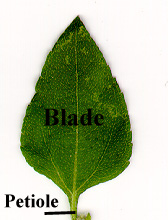Although leaves vary a lot, all of them have
the one basic job. They are needed to make sugars and other
carbohydrates (ie make food) through the process of
photosynthesis. Photosynthesis is where plants use light and
chlorophyll (the green material in leaves), and convert carbon
dioxide from the air and water from the soil into sugars and
oxygen.
Photosynthesis needs a lot of water. Once
this water is drawn up from the roots through the stems and into the
leaves, it meets carbon dioxide, which has entered the leaf through
the stomata, which are tiny pores mainly on the underside of
the leaf. These stomata take carbon dioxide into the leaf, as well as
letting oxygen out, and also excess water vapour. (This process is
called transpiration.) Since a leaf's interior tissues must be
moist but outside air is often dry, the stomata can close if they
need to, in order to prevent the plant drying out. Leaves can also be
protected from drying out by an outer coat (epidermis) that
may be hairy, extra thick, or waxy.
The process of transpiration is what makes
plants such an important part of our environment. We breathe out
carbon dioxide, which the plants take in, and they let out oxygen,
which we need to breathe in! A perfect relationship!
|

|
Photosynthesis stops in deciduous
plants (plants like the liquidamber outside the library,
that drop their leaves in autumn) during their leafless
dormant season, and it slows down a lot in evergreen plants
during very cold weather. For this reason, most plants
require much less water from late autumn to early
spring.
Anything that interferes with
photosynthesis and the transfer of sugars throughout the
plant can hurt the plant. For example, if leaves are cut by
pruning or chewed by insects, the injured tissue may seal to
prevent the loss of moisture, but the leaves will not
regrow. Now there will be less leaf area to make food for
the plant. Soot, grime, and dust on leaves can interfere
with free air circulation through the stomata and reduce the
amount of sunlight getting through to the leaves. A
smothering mat of leaves on a lawn can stop the production
of chlorophyll in the grass, causing it to turn yellow and
stop growing.
|
|
Sunlight acts on green chlorophyll
in leaves to convert water and carbon dioxide to sugars and
oxygen.
Leaves draw in carbon dioxide from
the air and give off oxygen.
The vascular system in stems
carries water to leaves from the roots, and also carries
sugars throughout the plant.
|
Back to
Top
